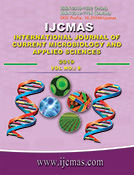


 National Academy of Agricultural Sciences (NAAS)
National Academy of Agricultural Sciences (NAAS)

|
PRINT ISSN : 2319-7692
Online ISSN : 2319-7706 Issues : 12 per year Publisher : Excellent Publishers Email : editorijcmas@gmail.com / submit@ijcmas.com Editor-in-chief: Dr.M.Prakash Index Copernicus ICV 2018: 95.39 NAAS RATING 2020: 5.38 |
Apple (Malus × domestica) is an important fruit crop cultivated worldwide. Apple orchards are exposed to a diverse set of environmental and biological factors that affect the productivity and sustainability of the apple cultivation. Many of the efforts for apple production rely on reducing the incidence of fungal diseases, and one of the main diseases is apple scab caused by the fungus Venturia inaequalis (Cooke) Wint. Apple scab is the most devastating important disease of cultivated apple causing economic losses in terms of fruit quality and yield in many apple growing areas. Apple scab attacks foliage, blossoms and fruits, resulting in the defoliation of trees and making the fruits unmarketable. If the disease is not controlled effectively, more than 80 percent fruits of susceptible cultivars can be damaged. Depending on the severity of disease, 10 to 15 or even more fungicidal applications are usually needed for efficient control. The uncontrolled disease may result in almost devastation of whole crop. The main strategy used for scab control is still the frequent application of fungicides throughout the season. However, selection pressure has lead to the evolution of fungicide-resistant strains of scab that represent a threat to the apple industry. Therefore, all the research work in apple growing regions will be focus on identifying and creating commercial varieties with long lasting resistance characteristics and develop alternative strategies to manage apple scab. Main strategies for effectively managing apple scab includes use of resistant cultivars, tolerant rootstock, effective control of primary and secondary infection through use of an integrated crop management system, biological control, use of biotechnological approaches that maximizes yield and quality of apple.
 |
 |
 |
 |
 |